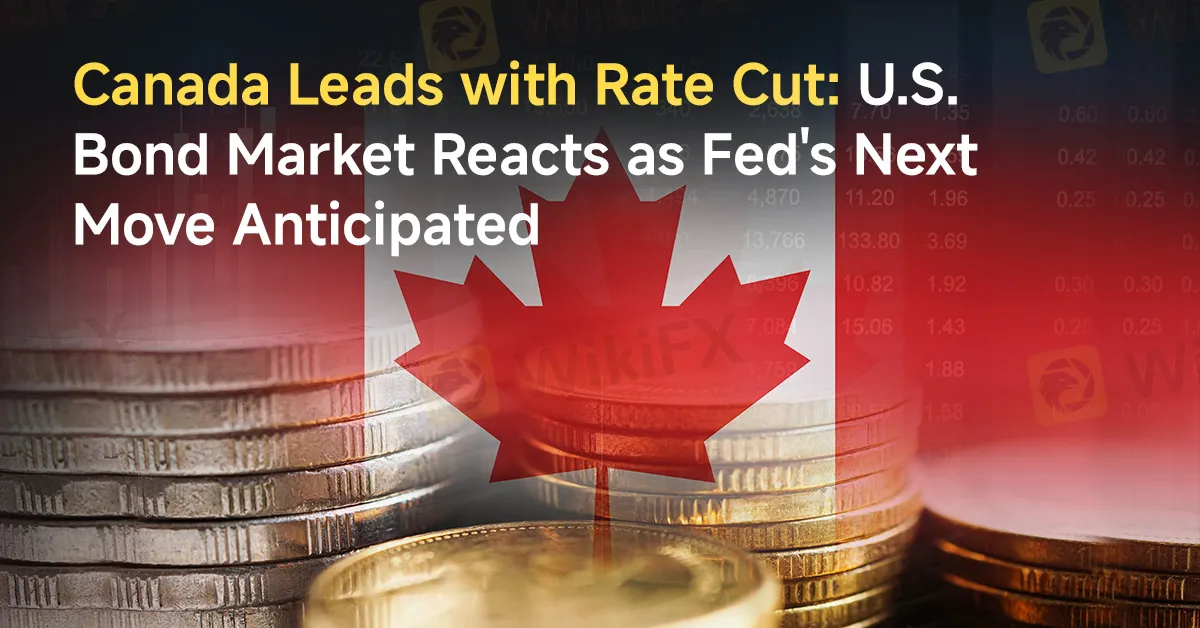Canada Leads with Rate Cut: U.S. Bond Market Reacts as Fed's Next Move Anticipated
Abstract:According to Bloomberg, in a decisive move, the Bank of Canada (BoC) has reduced its key interest rate by 25 basis points to 4.50%, marking the first rate cut among G7 nations and widening the policy rate gap with the Federal Reserve to its largest since 2007. This move signals potential further easing, intensifying speculation around the Federal Reserve's upcoming decisions. ING anticipates a Fed rate cut in September, but the volatile U.S. bond market suggests a potential move as soon as next week.

According to Bloomberg, in a decisive move, the Bank of Canada (BoC) has reduced its key interest rate by 25 basis points to 4.50%, marking the first rate cut among G7 nations and widening the policy rate gap with the Federal Reserve to its largest since 2007. This move signals potential further easing, intensifying speculation around the Federal Reserve's upcoming decisions. ING anticipates a Fed rate cut in September, but the volatile U.S. bond market suggests a potential move as soon as next week.
BoCs Doveish Stance
BoC Governor Tiff Macklem's statements and press conference remarks bolstered dovish expectations following the rate cut. Emphasizing the downside risks to the economy, Macklem stated, “We need economic growth to rebound so that inflation doesnt fall too much, even as we strive to bring inflation down to our 2% target.” While ING considers this a moderate view, the BoC's new quarterly forecast reflects cautious optimism, projecting overall and core inflation to hit 2.0% by the end of next year, with GDP growth forecasts adjusted downward to 1.2% for 2024 and 2.1% for 2025.
Interest Rate Differential Concerns
Analysts highlight concerns over the widening interest rate differential between the BoC and the Fed, currently at -100 basis points. This is the most significant negative differential since 2007, and should the BoC cut rates again before the Fed, it would create the largest gap in 25 years. However, the BoCs primary concern does not appear to be this differential.
Currency Implications
There are worries about the Canadian dollar (CAD) depreciating excessively against the U.S. dollar (USD) due to divergent central bank policies. ING notes, “We must acknowledge that the BoC‘s latest statement and monetary policy report did not address forex-related inflation risks. Notably, since the BoC’s rate cut in mid-July, the USD/CAD has risen by just 1.2%, less than other G10 currency pairs. As long as USD/CAD remains around 1.38 or higher, concerns over excessive currency depreciation should be minimal.”
Market Expectations and Future Moves
Despite the current dovish outlook, market expectations for the BoCs September 4 meeting are at -15 basis points, possibly due to the timing being two weeks before the Fed's meeting. Post rate cut, year-end expectations have hovered around -45 basis points.
ING aligns with market forecasts, predicting the BoC to pause in September, followed by 25 basis point cuts in October and December. Macklems dovish comments suggest a higher likelihood of a September cut, heavily dependent on inflation trends and economic health. “Macklem seems to have shifted focus from inflation to growth, indicating a potential September cut,” ING remarks.
Fed's Influence and Potential Rate Cut
The Fed's policy will significantly influence market expectations. If the market prices are in a September Fed rate cut, it may partially expect a BoC cut in the same month. ING's base case predicts the Fed cutting rates in September, possibly leading the BoC to cut rates two weeks earlier. This could increase the likelihood of additional cuts by the BoC before year-end.
Impact on CAD
The CAD has shown resilience despite the BoC's rate cut, reflecting the move in prices. Recently, the CAD has outperformed the AUD, NZD, NOK, and SEK. This trend may continue in the short term due to reduced risks from the new Trump administration compared to other high-beta G10 currencies, and better liquidity in the CAD, making it more resistant to risk-off sentiment.
However, the widening USD/CAD interest rate differential suggests continued upward pressure on the currency pair. ING forecasts a potential break above 1.380 and an extension towards 1.390 if the market fully prices in a September BoC cut. A Fed policy easing could trigger a USD/CAD pullback in the short term. “We still hold a medium-term bullish view, expecting USD/CAD to fall below 1.350.”
Conclusion
Former New York Fed President William Dudleys recent call for the Fed to cut rates next week to counter recession fears has added fuel to the speculation. This marks a significant shift from his long-held view that the Fed would maintain high rates for an extended period.

Read more

Warning Against Globalmarketsbull & Cryptclubmarket
Are you thinking about investing in Globalmarketsbull or Cryptoclubmarket? Think again! The Financial Conduct Authority (FCA) issued a warning about these two firms. Here are the details of these unlicensed brokers.

Why Even the Highly Educated Fall Victim to Investment Scams?
Understanding why educated individuals fall victim to scams serves as a stark reminder for all traders to remain vigilant, exercise due diligence, and keep emotions firmly in check.

Italy’s CONSOB Blocks Seven Unregistered Financial Websites
Italy’s CONSOB ordered seven unauthorized investment websites blocked, urging investors to exercise caution to avoid fraud. Learn more about their latest actions.

CySEC Warns Against Unauthorized Investment Firms in Cyprus
CySEC warns investors about unregulated investment firms in Cyprus. Verify broker reliability through the WikiFX app to stay protected from scams.
WikiFX Broker
Latest News
Revolut X Expands Crypto Exchange Across Europe, Targeting Pro Traders
Broker Review: Is Exnova Legit?
Capital.com Shifts to Regional Leadership as CEO Kypros Zoumidou Steps Down
Crypto Scammer Pleads Guilty in $73 Million “Pig Butchering” Fraud
CWG Markets Got FSCA, South Africa Authorisation
Amazon launches Temu and Shein rival with \crazy low\ prices
CySEC Warns Against Unauthorized Investment Firms in Cyprus
Why Even the Highly Educated Fall Victim to Investment Scams?
Warning Against Globalmarketsbull & Cryptclubmarket
FBI Raids Polymarket CEO’s Home Amid 2024 Election Bet Probe
Rate Calc

